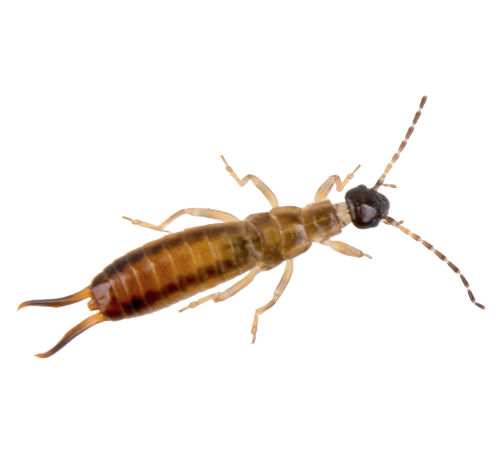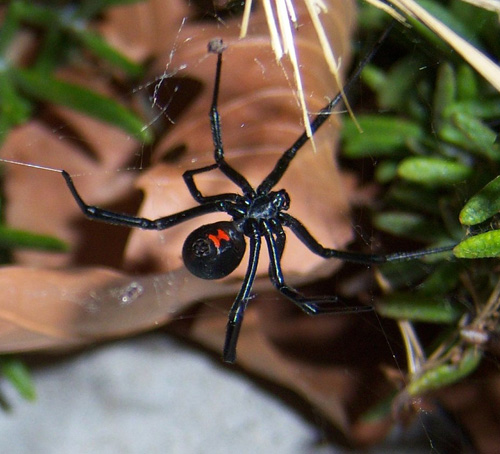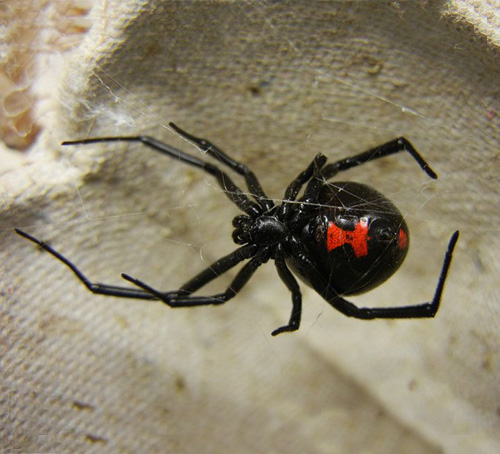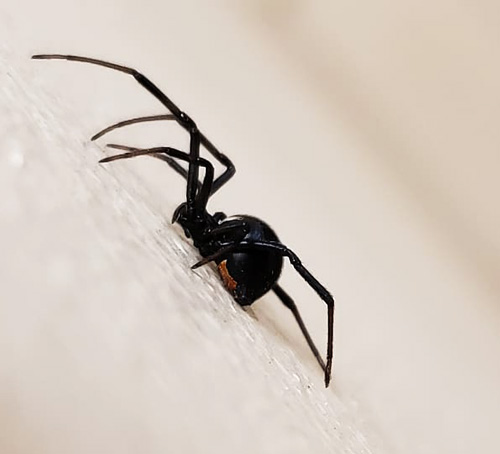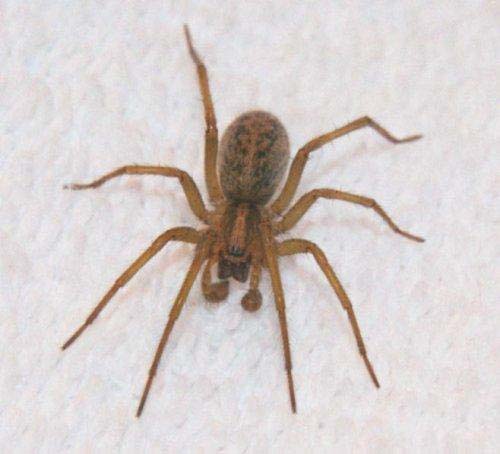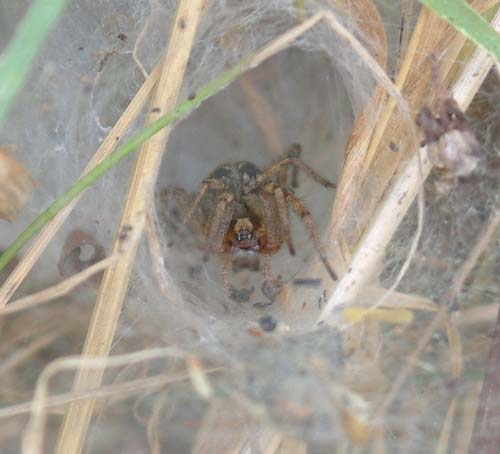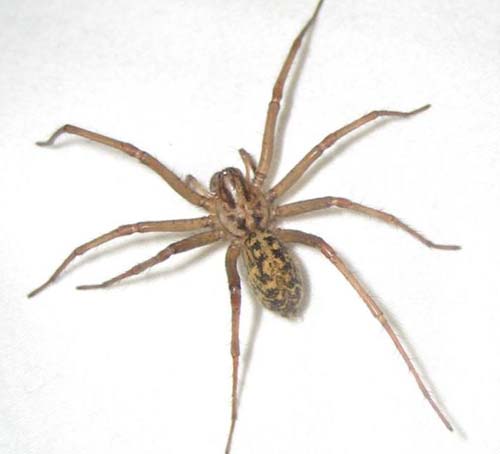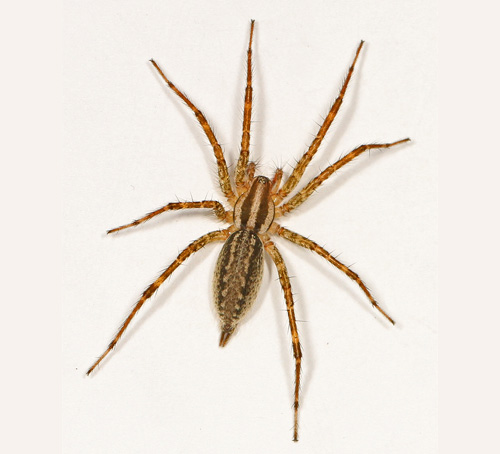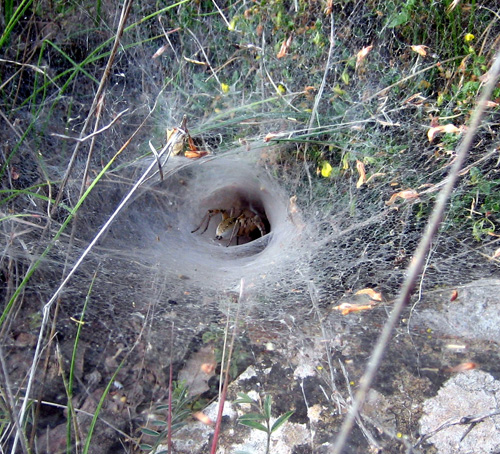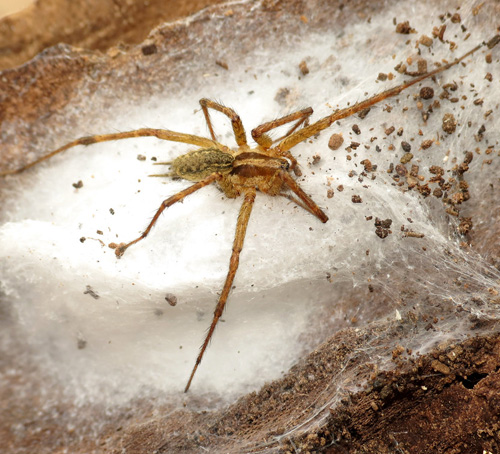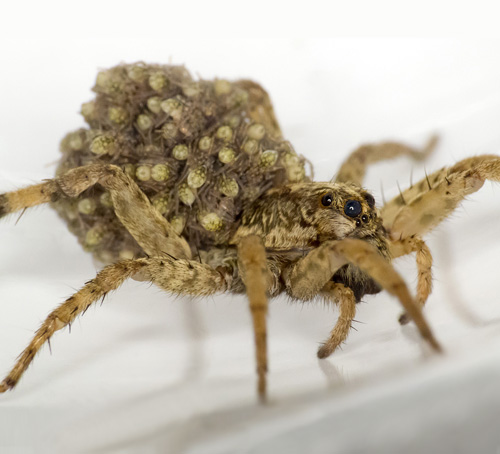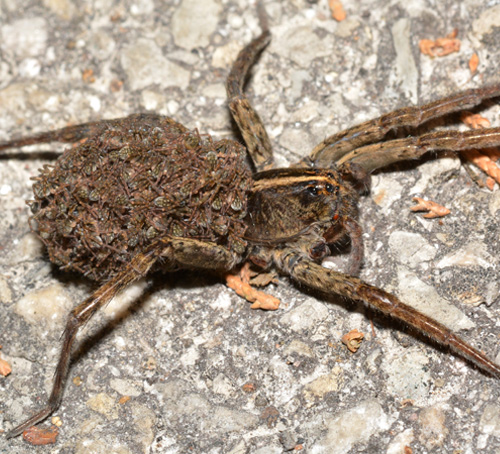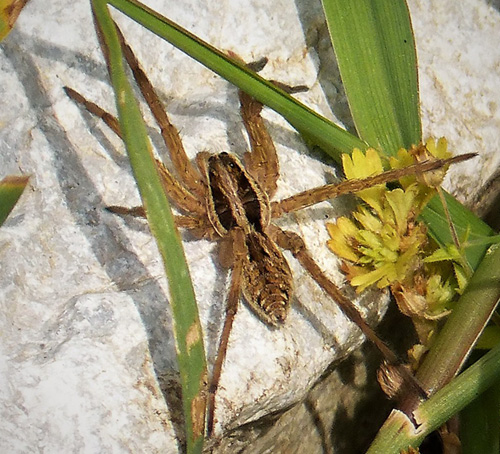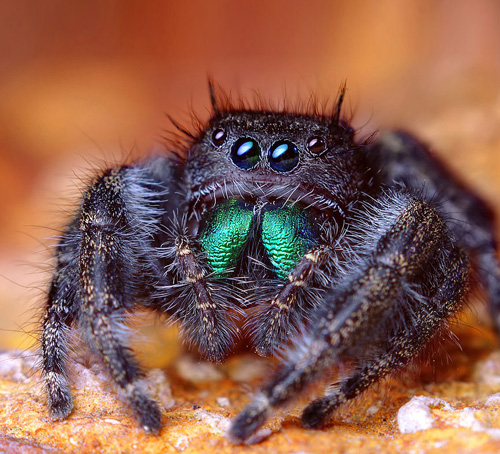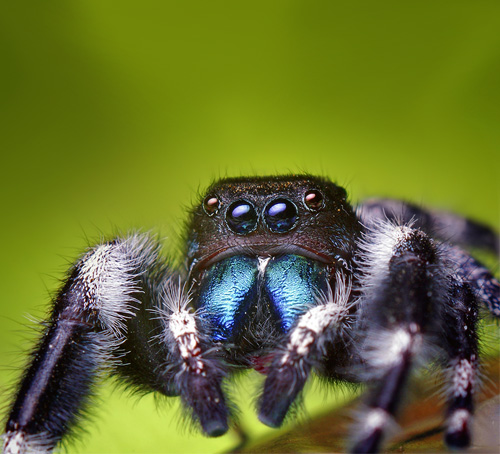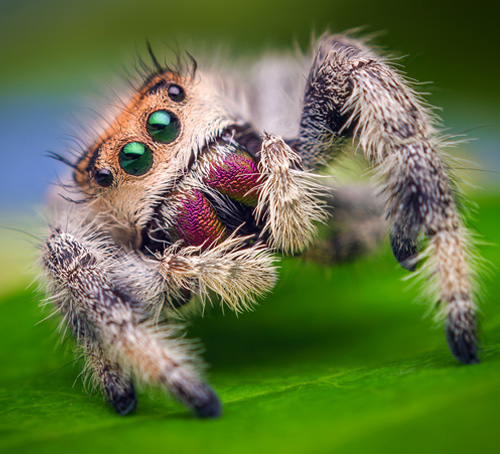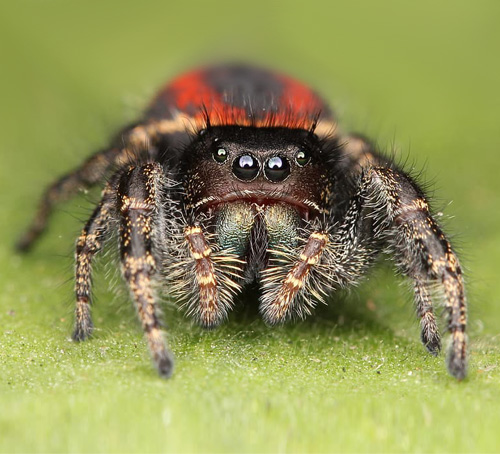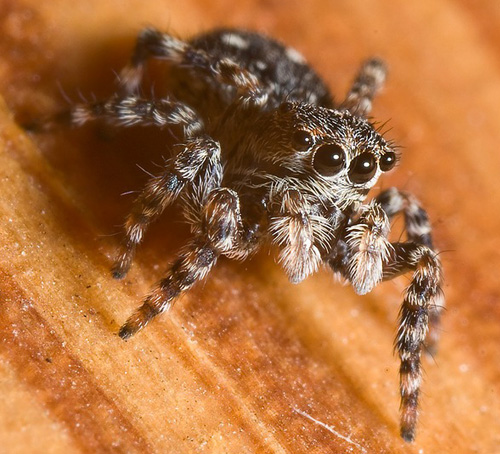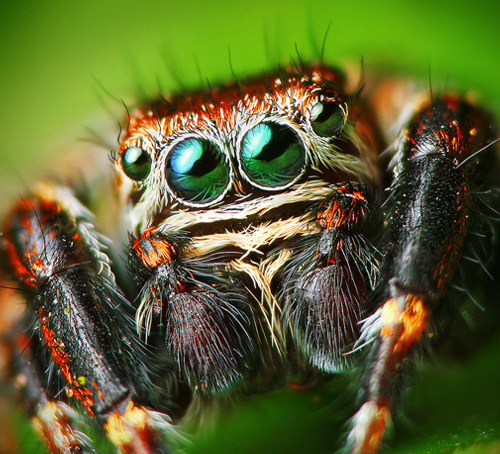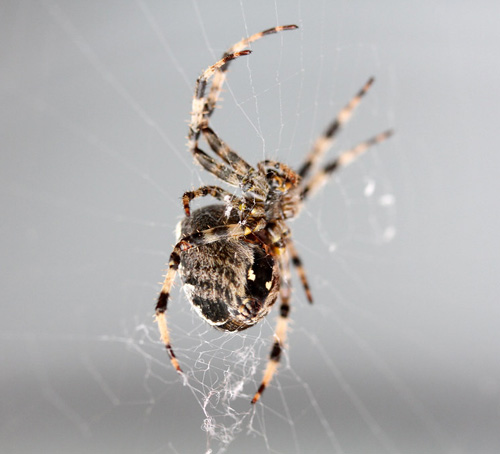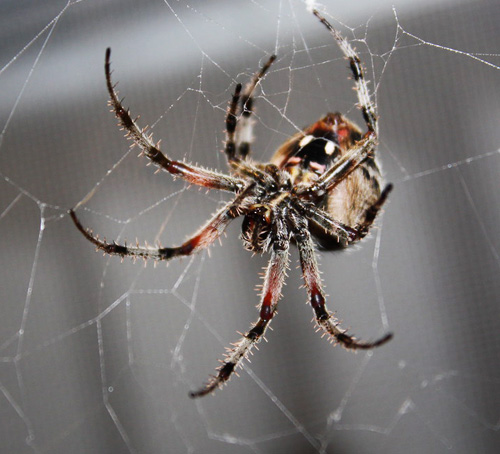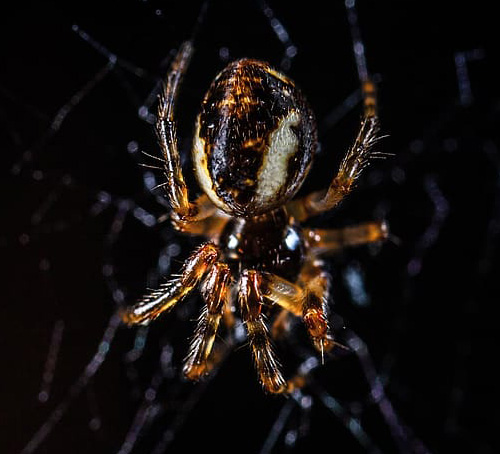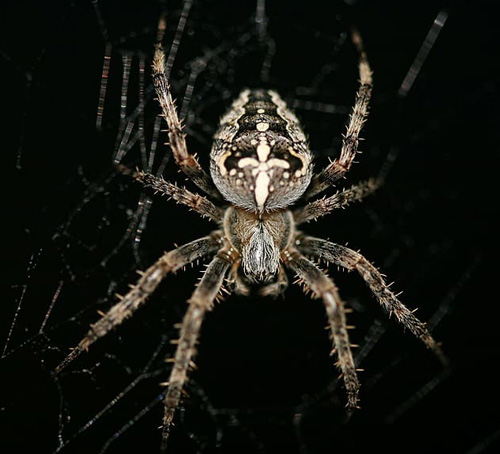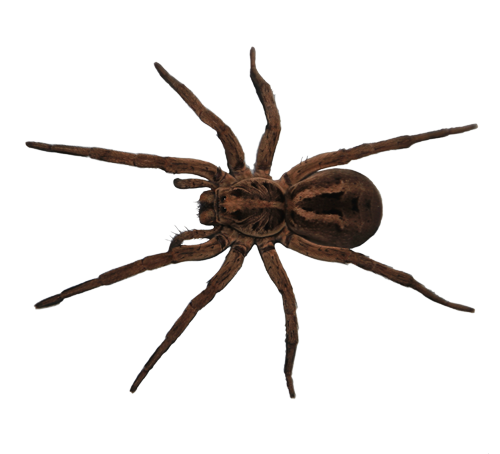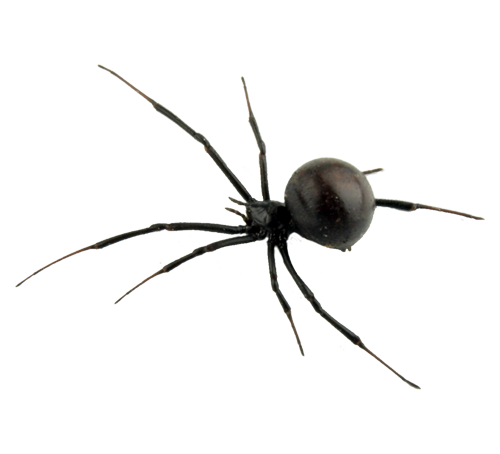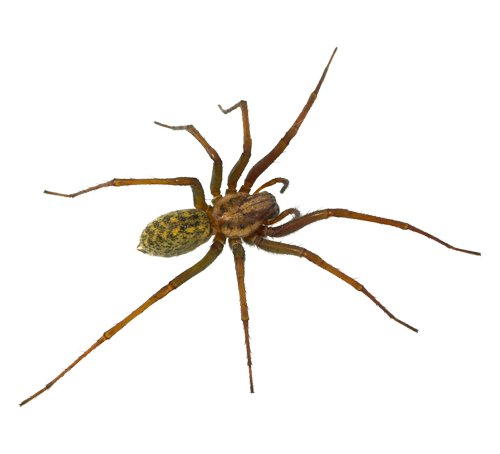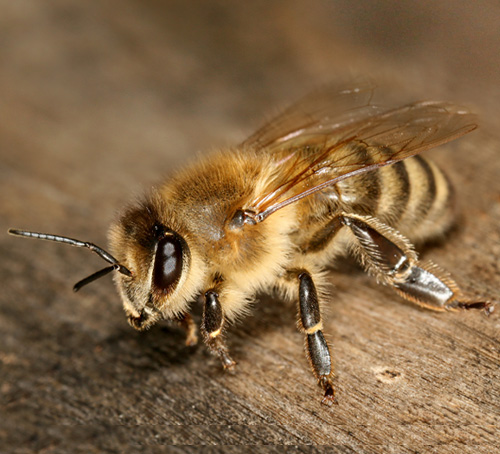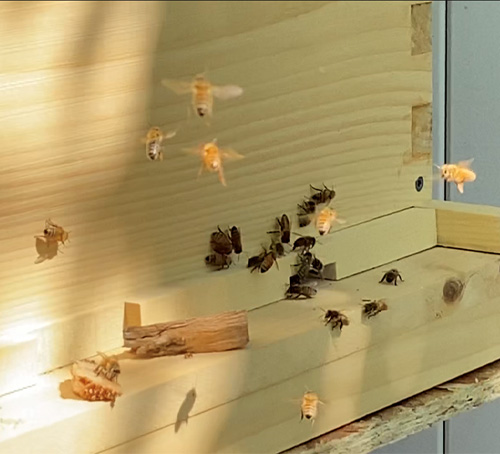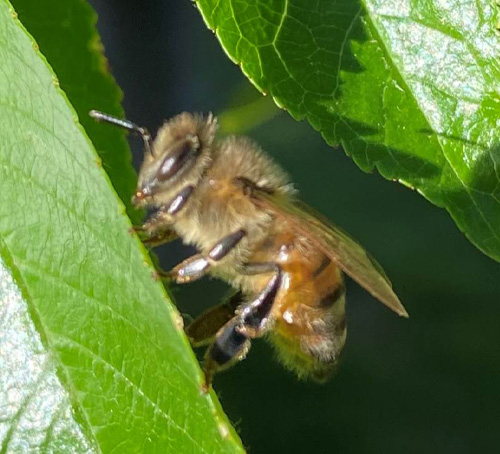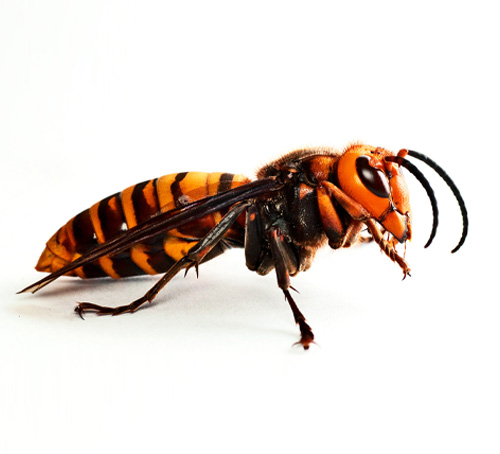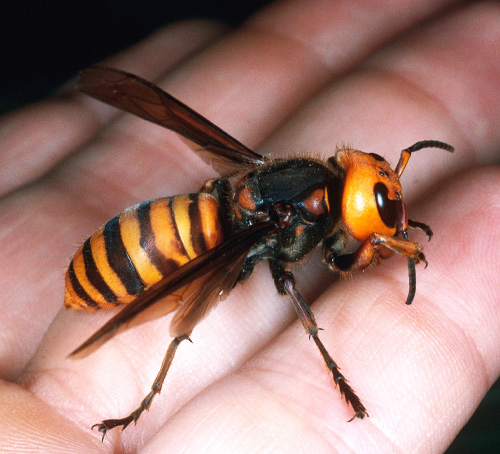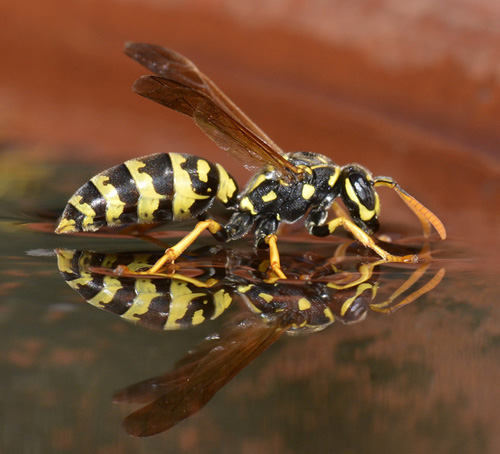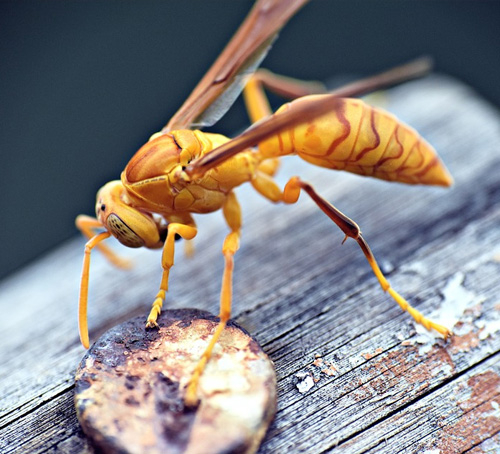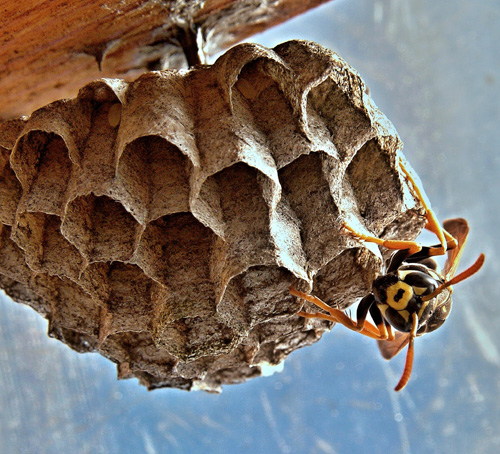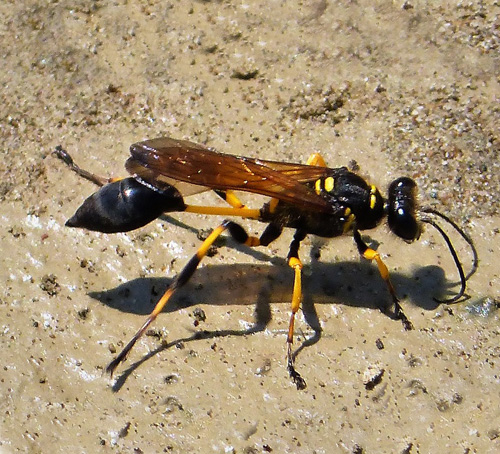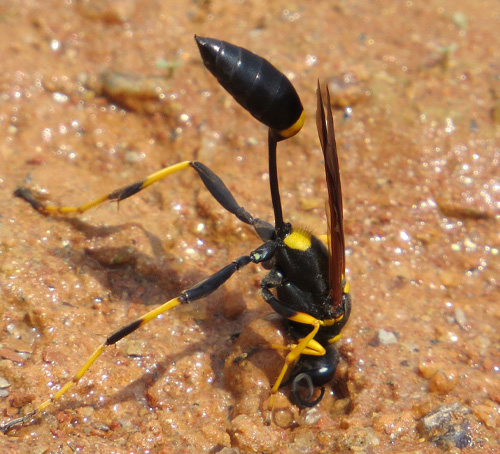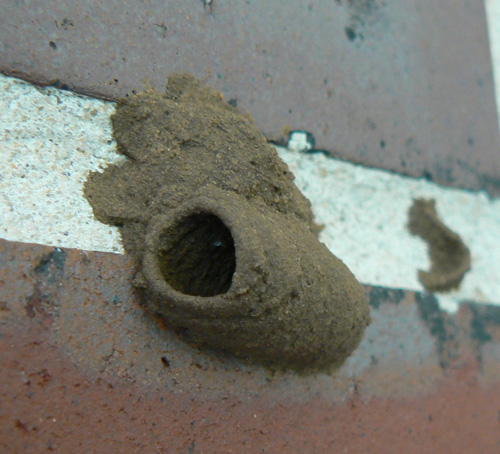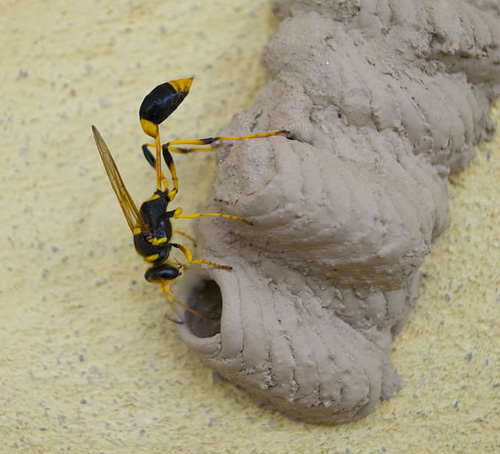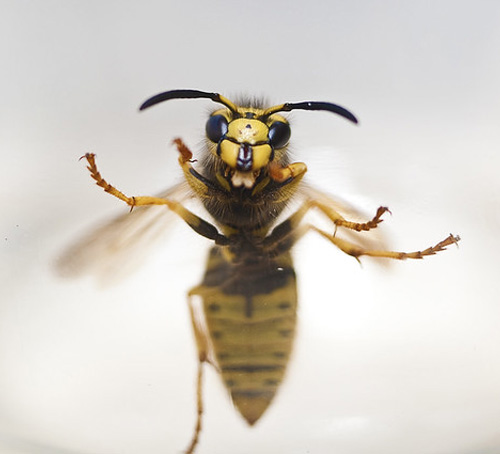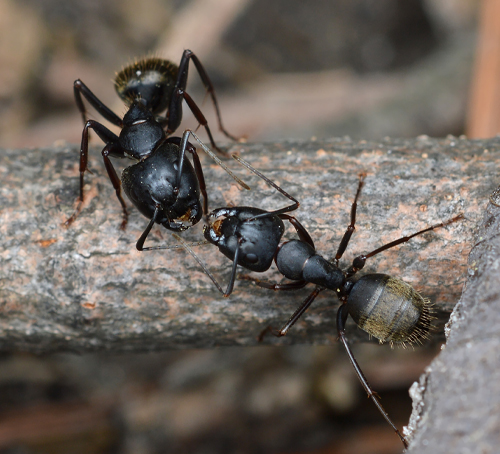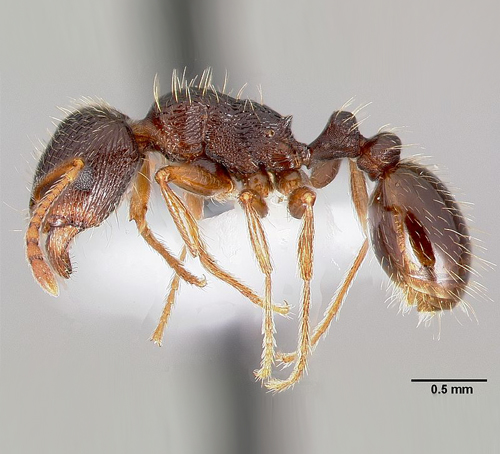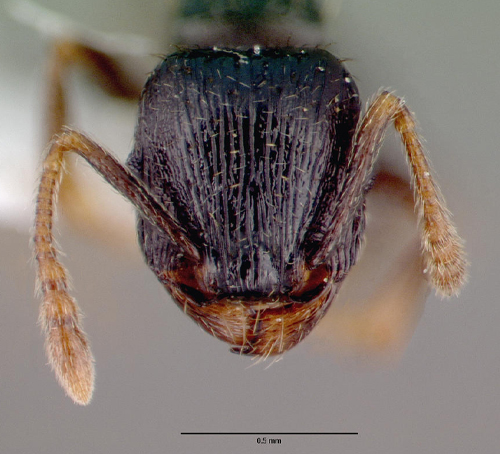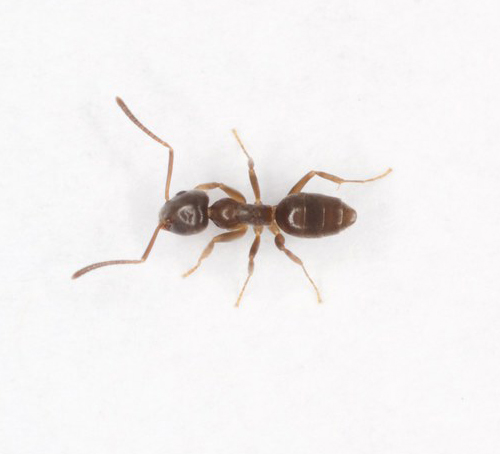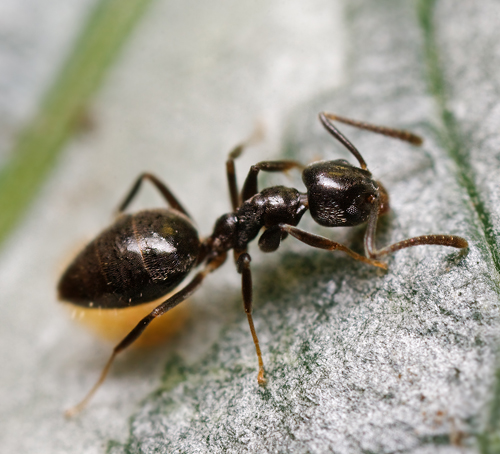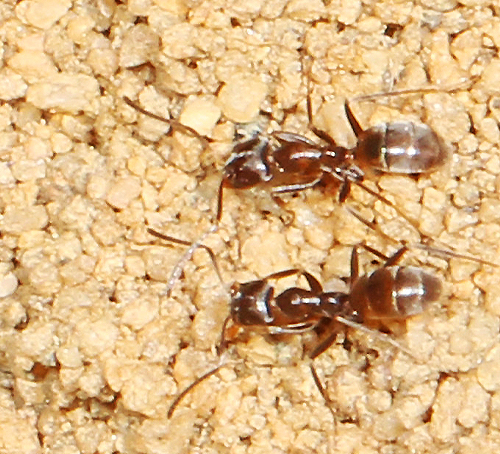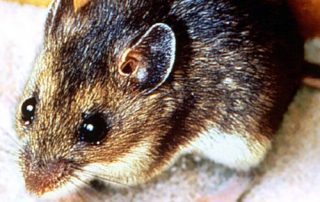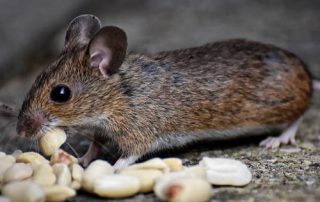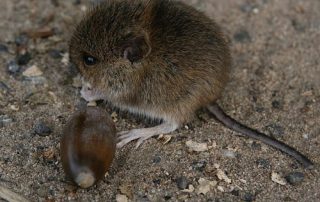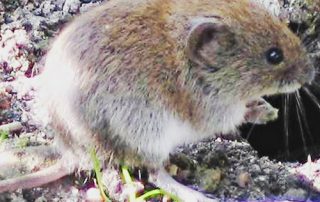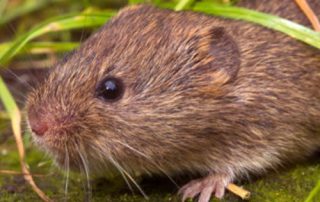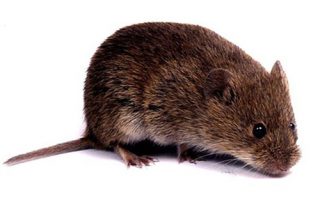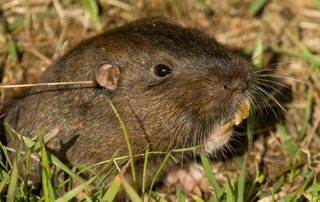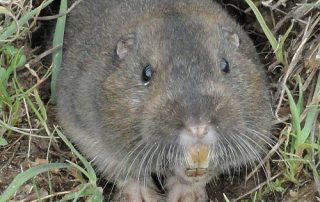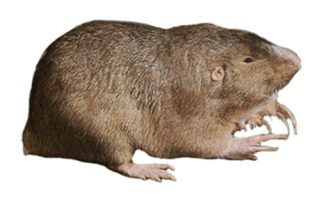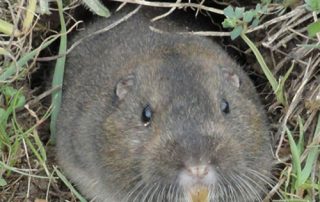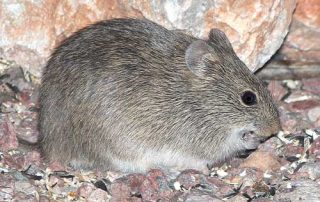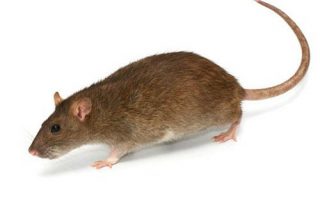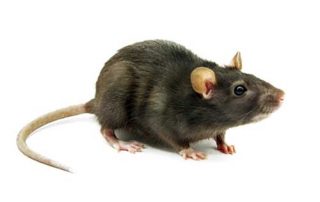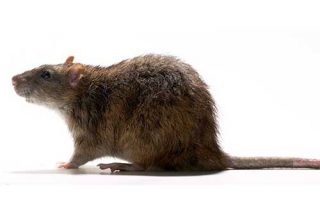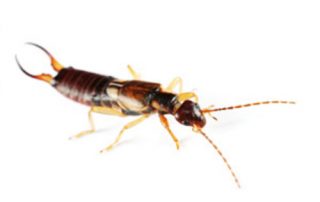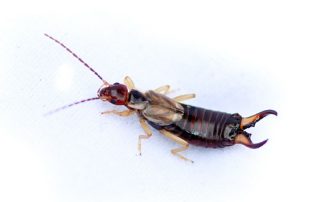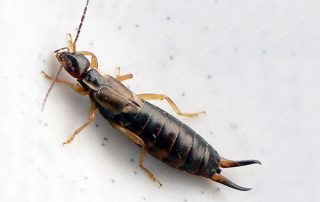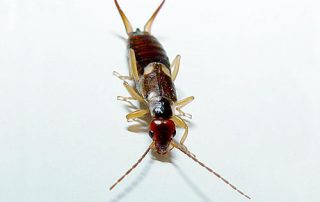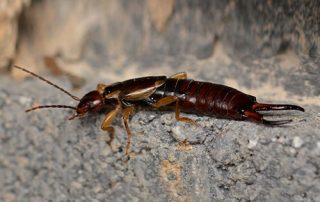Pest Library
Spiders
In Idaho, there are myriad common spiders in and out of your homes. Click on the various species listed below to read more about how to identify the spiders you’re seeing around your home. We’ve also provided articles you can go to to learn more about some myths regarding spiders.
Black Widow Spiders
Venom toxicity – The Black Widow Spider can inflict a painful bite, which can be fatal – especially to the young and elderly. An effective anti-venom was developed in 1956. Only a small amount of venom can cause serious illness, as the poison attacks the nervous system. Systemic envenomization usually results in headache, nausea, vomiting, abdominal pain, pyrexia, and hypertension. The pain around the bite area can be excruciating or it may go unnoticed. First aid and medical attention should be sought as soon as possible, if bitten. If you have a heart condition or other heart problems, you may need hospitalization.
Spider identification – The body of an adult black widow is about 1/2 inch long. The female black widow is normally shiny black, with a red hourglass marking on the underside of the abdomen. The marking may range in color from yellowish orange to red and its shape may range from an hourglass to a dot.
Habitat – Prefers woodpiles, rubble piles, under stones, in hollow stumps, sheds, and garages. Indoors it can be found in undisturbed, cluttered areas in basements and crawl spaces.
Hobo Spiders
Venom toxicity – Although the bit of the hobo spider is initially painless, the bite can be serious. After 24 hours, the bite develops into a blister and after 24-36 hours the blister breaks open, leaving an open, oozing ulceration. Typically, when the venom is is injected, the victim will experience an immediate redness, which develops around the bite. The most commonly reported symptom is a sever headache. Other symptoms can include nausea, weakness, fatigue, temporary loss and vision impairment. In any case, first aid and medical attention should be sought if bitten, as and when any adverse health effects are observed.
Spider identification – They are brown in color and the adults measure roughly 1/3 to 2/3 inches in body length and 2/3 to 2 inches in leg span. Their abdomens have several chevron shaped markings. Males are distinctively different from females in that they have two large palpi (mouth parts) that look like boxing gloves. Females tend to have a larger and rounder abdomen when compared to males.
Habitat – They can be found anywhere in Washington, Oregon, Idaho, Montana, Wyoming, Utah, and Colorado. They rarely climb vertical surfaces and are uncommon above basements or ground level. They are a funnel web spider.
Grass Spiders
Venom toxicity – The bite of these spiders is of low risk to humans.
Spider identification – are common outdoors and are occasionally found indoors. They are generally brownish or grayish with light and dark stripes near the head. They have long spinnerets and are moderate-sized (3/4 inch long). Grass spiders construct a large sheet web with a funnel they use as a retreat. These webs are commonly built on the ground, around steps, window wells, foundations, and low shrubs.
Habitat – These spiders are often called grass spiders because they construct their webs in tall grass, heavy ground cover, and the branches of thick shrubs. Rarely will a funnel web spider be seen indoors, except for an occasional wandering male. They are found mostly in the Pacific Northwest states.
Wolf Spiders
Venom toxicity – The bite of the Wolf Spider is poisonous, but not lethal. Although non-aggressive, they bite freely if provoked and should be considered dangerous to humans. The bite may be very painful. First aid and medical attention should be sought as soon as possible, particularly as to children or the elderly.
Spider identification – An adult is 1/2 inch to more than 1 inch in body length – molted gray to brown in color, with a distinct Union Jack impression on its back. The female carries its young on its back.
Habitat – This spider is a ground dweller, with a burrow retreat. It has a roving, nocturnal lifestyle to hunt their prey and can move very rapidly when disturbed. Commonly found around the home, in garden areas with a silk-lined burrow, sometimes with a lid or covered by leaf litter or grass woven with silk as a little fence around the rim of the burrow.
Jumping Spiders
Venom toxicity – They have venom they use to control their prey, but this venom is not dangerous to humans. A jumping spider bite is usually nothing more than a small red welt.
Spider identification – Jumping Spiders come in various styles and colors, black, brown, white with varied markings on various parts of their body in white, gray, yellow, orange, red, and blue. They are typically very small, between 2-10mm, and can be covered in brightly colored hairs that can appear iridescent.
Habitat – They are found primarily in your garden or on foliage, but will hunt anywhere they can find prey. In the house, they would normally be by doors or windows.
Orb-Weaver Spiders
Venom toxicity – Reluctant to bite, Orb-Weavers are little threat to humans. Symptoms include mild locale pain, numbness, and swelling. Dizziness and nausea can occur in rare cases.
Spider identification – Orb-weaving spiders are three-clawed builders that are most identifiable by their flat webs of sticky spiral capture silk. The building of a web is an engineering feat, begun when the spider floats a line on the wind to another surface. The spider secures the line and then drops another line from the center, producing a “Y” shape. The rest of the web is then constructed before the final sticky capture spiral is woven into place. There are more than 2800 known orb-weaving species.
Habitat – You’ll commonly find orb-weavers in your garden or among shrubbery around your home.
Spider Biology and Behavior
Life Cycle
Spiders grow from eggs to spiderlings and into adults by molting – usually 5-10 times. Once they reach adulthood, most spiders stop molting and do not grow to larger sizes.
The majority of spiders in Treasure Valley survive the winter as immature spiderlings in protected places though some do overwinter as eggs and adults. All spiders make silk, but not all spiders use their silk to make webs. Other common uses of silk include draglines, egg-case coverings, and ballooning.
Draglines: single threads that they trail behind them similar to safety ropes used by a person climbing a mountain. When threatened, the spider quickly drops to the ground on the dragline and escapes danger. Draglines often become household nuisances when the threads become covered in dust and appear as cobwebs in corners and along ceilings.
Egg Case: Female spiders protect their eggs by wrapping them into a case with a tough outer silk coat. The so-called “eggs” seen on webs, attached to the tip of the female’s abdomen or the outside of your home, are in-fact egg cases or egg sacs, containing dozens or hundreds of eggs.
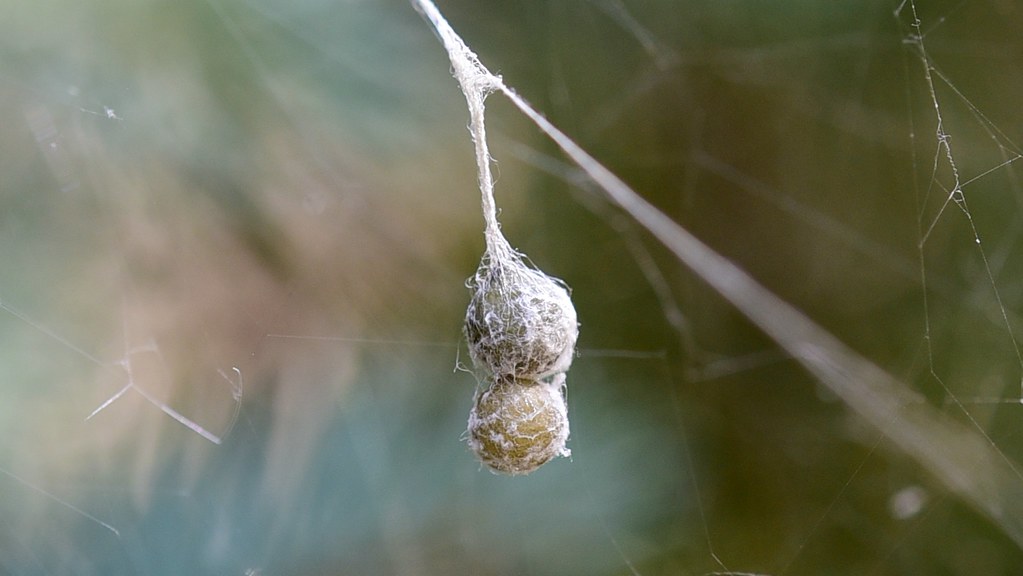
Ballooning or Parachuting: When spiderlings hatch, they crawl to the top of a plant or other perch and make a silk strand that is lifted by the wind. When the silk line is long enough, the spider is randomly carried aloft to a new location. The seemingly invisible webbing that you feel across your face or arms in the spring and summer is probably the silk thread of a ballooning spider.
Ballooning Spiders Fact: Spiders can literally be carried across oceans by ballooning, and so are among the first to colonize lands where widespread natural disasters have eliminated living creatures. After the eruption of Mount St. Helens, spiders drifted in one summer at nearly 10 individuals per square foot.
Food Habits
All spiders are carnivorous. Most feeding on insects, other arachnids, and other small arthropods; just about anything the trap in their webs or hunt down and capture. They kill prey by envenomization – they bite prey with their fangs and inject it with venom. Most spiders inject prey with digestive enzymes that dissolve body tissues, which then are sucked up as liquids into the stomach. Some spiders macerate prey between their chelicerae and then ingest the fluids.
Spider Bites
Technically speaking, essentially all (99.6%) of North American spider species are venomous; the produce chemical toxins that they inject into their prey by means of fangs located at the tip of their jaws. But, except for the black widow spider and hobo spider, the spiders that occur in Idaho are not poisonous to people. Either they cannot bite people or, if they can bite, their venom is not toxic enough to harm humans.
Bees, Hornets, & Wasps
Below are common bee and wasp species found in our area, including one that is rumored to be coming. While each belong to the Hymenoptera Order, each species has distinct characteristics and habists. Wasp species are categorized as social or solitary. As their name implies, social wasps live in colonies, which may numver in the thousands. Solitary wasps live alone and rarely build nests. Some wasps are aggressive species, which sting when threatened. Unlike honey bees, wasps are capable of stinging multiple times.
Click the links below to learn more about each species to read more about identification and specific dangers.
Honey Bees
Honey bees, one of the most popular bees, represent only a small percent of the bee species. They are known for producing and storing honey (or liquefied sugar) as well as building impressively large nests using wax secreted by workers in a particular colony. Honey bees measure about 15 millimeters long and are light brown in color. When new queens leave their old colonies along with thousands of workers in late-Spring and Summer, large groups of bees can be seen swarming together as they find a new nesting place. It takes a swarm approximately 24 hours to locate a new nesting site.
Their sting is painful, but normally only last for a few hours. However, some people can have an allergic reaction ranging from a mild to severe anaphylactic shock and possibly death – if not treated immediately. Honey Bee stingers are a barb that sticks in the skin and tears out of the bee. It can sting only once, resulting in the death of the bee.
Asian Giant Hornet (a.k.a. Murder Hornet)
The Asian Giant Hornet (vespa mandarinia) is fairly common in many parts of Asia, where it is called the “Giant Hornet.” These insects are large and distinctive, with a characteristic orange head and black-banded orange body. Like any other social wasp, they will defend their nest if the colony is disrupted. But in most cases, the will not do anything if people aren’t aggressive toward them.
Giant Hornets have longer stingers than a honey bee, and hornets do not break off their stingers when they sting. Because hornet stingers can puncture thick clothing, people should avoid nests whenever possible.
The sting is painful, but the swelling and pain will – in most cases – subside in a few days.
Just as with honey bee stings, an allergic reaction, or anaphylaxis, can occasionally put people in the hospital. In rare cases, severe reactions can become fatal. That said, wasp and hornet stings killed less than 13 people per year in 2017 and 2018 in Japan; less than 0.00001% of the national population in a country where many people spend time outdoors.
If you are allergic to bee and wasp stings, it is best to avoid getting close to these insects and their nests, wear white clothing outdoors (they are attracted to dark colors), and avoid carrying open-top sweet drinks – such as sodas – into the woods.
Giant Hornets are fairly common in mountainous regions of Asia, but are often also seen in large cities or highly urbanized areas. They usually nest at the base of large trees and inside dead logs. The fact that they can’t tolerate extremely hot or cold temperatures makes it unlikely they would spread to areas in North America that are very hot or cold.
If active colonies are discovered in 2020 in the Pacific Northwest, which is a more temperate climate, it’s possible they could spread in that reagion. However, it is unlikely this would happen quickly as foraging ranges of Vespa are only about 2,300 feet (700 meters) from their nests.
Paper Wasp
Paper wasps measure approximately 1 inch in length. Their narrow bodies are most commonly dark brown in color, with black wings, and yellow markings. These insects are called paper wasps due to the construction of their nests. Made from small wood or plant fibers combined with saliva, paper wasp nests appear to be made from paper. These nests are frequently found in sheltered areas such as tree branches, under decks, and the eves of houses. Stings from paper wasps are extremely painful and may produce allergic reactions.
Mud Dauber Wasp
Mud dauber (sometimes referred to as “dirt dauber”, “dirt digger”, “dirt dobber”, “dirt diver”, or “mud wasp”) is a name commonly applied to a number of wasps that build their nests from mud. These long, slender wasps are named from their nests – that are made by the females, which consist of mud molded into place by the wasp’s mandibles. They are the primary predator of the black and brown widow spiders. Mud daubers are rarely aggressive and stings by this species are very uncommon.
Yellow Jackets
Yellow jackets are wasps that can be identified by their alternating black and yellow body segments, small size, and distinctive side-to-side flying pattern. They measure between 1/2 inch to 1 inch in length and often mistaken for honey bees, although their bodies lack the hair and rounded abdomen of the honey bee. These social wasps live in colonies that may contain one thousand insects at a time. Many yellow jackets are ground-nesters. Their colonies can be found under porches or steps, in sidewalk cracks, around railroad ties, or at the base of trees or bushes. Sometimes the queen finds an abandoned rodent burrow to use as a nesting place. Some yellow jackets build aerial nests in bushes, low-hanging branches, or in the corners of buildings and other man-made structures. Yellow jackets are attracted to garbage and other human foods.
Known to be aggressive defenders of their colonies, yellow jackets are otherwise not quick to sting. The sting of a yellow jacket is painful and each insect is capable of delivering multiple stings. Because they are equipped with lance-like stingers without barbs, yellow jackets are also capable of stinging repeatedly. Yellow jacket stings may induce sever allergic reactions in some individuals.
Bald-Faced Hornet
Bald-faced hornets are more closely related to yellow jackets than they are to hornets. Hornet nests are composed of a paper substance derived from saliva and wood pulp. They are located within or atop trees, in attic rafters, and in other covered areas.
The Giant Hornets closely resemble the bald-faced hornets. Their nests may be located near or inside a home and may prove extremely dangerous to humans. Hornets are typically aggressive and some individuals may be allergic to their sting.
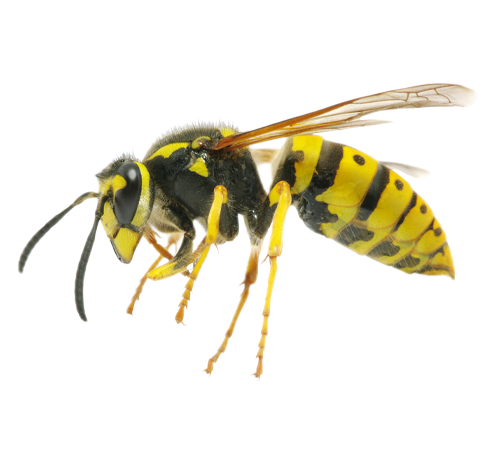
Ants
Ants are located all over the world and are destructive to food and property. They can also bring diseases and health risks in your home. In some parts of the world, ants can even sting and be dangerous. PestEx has the ant control treatment options you can rely on to get rid of ants found around your property and in your home.
The first step in eliminating an ant infestation in your home is to identify the species of ant. Not all ants are created equal; therefore understanding their biology and the specific species’ differences is critical in developing the proper control strategy – which leads to success in eliminating the ants from your home. Do-it-yourself ant control methods usually don’t produce the desired result and sometimes make the problem worse. PestEx can help with ant control and recommend the best solution for your specific ant problem.
Carpenter Ants
If you have seen large, black ants, they may be carpenter ants. The western black carpenter ant (camponotus modoc) is found right here in the Treasure Valley. These large ants are black and their legs are dark red. Workers are about 1/4 to 1/2 inches in length (queens are larger). Western black carpenter ant workers are dull black in color; their legs are reddish and their abdomens have golden hairs.
Carpenter ants have a formidable bite and are capable of introducing formic acid, so contact a medical professional if bitten.
Carpenter ants do not eat wood, rather burrow into it making pathways and nests, destroying much of the wood. Due to the property damage carpenter ants may cause, you should get in touch with a pest professional as soon as possible if you see carpenter ants on your property.
Photo credits:
- Carpenter ant dorsal view Citation: AntWeb. Version 8.39.1. California Academy of Science, online at https://www.antweb.org. Accessed 26 June 2020. Photographer: April Nobile
- Carpenter ant side view Citation: AntWeb. Version 8.39.1. California Academy of Science, online at https://www.antweb.org. Accessed 26 June 2020. Photographer: April Nobile
- Capenter ant Head Citation: AntWeb. Version 8.39.1. California Academy of Science, online at https://www.antweb.org. Accessed 26 June 2020. Photographer: April Nobile
Little Black Ants
There are several types of little black ants. Two of the most common are: Pavement Ants and Odorous Ants. In general, they use dead and alive insects for food, as well as feces of aphids and scales. They may turn to food inside, such as grease and oil – and are known to invade open pet food containers and bowls. Little black ants reside beneath debris and stones, and can also take up nests in wall voids and beneath carpets.
Photo credits:
- Head Odorous ant Citation: AntWeb. Version 8.39.1. California Academy of Science, online at https://www.antweb.org. Accessed 26 June 2020.
Photographer: April Nobile - Side view odorous AntWeb. Version 8.39.1. California Academy of Science, online at https://www.antweb.org. Accessed 26 June 2020.
Photographer: April Nobile - Dorsal view Odorous AntWeb. Version 8.39.1. California Academy of Science, online at https://www.antweb.org. Accessed 26 June 2020. Photographer: April Nobile
Ant Biology and Behavior
Ants undergo complete metamorphosis, developing through four stages: egg, larva, pupa, and adult.
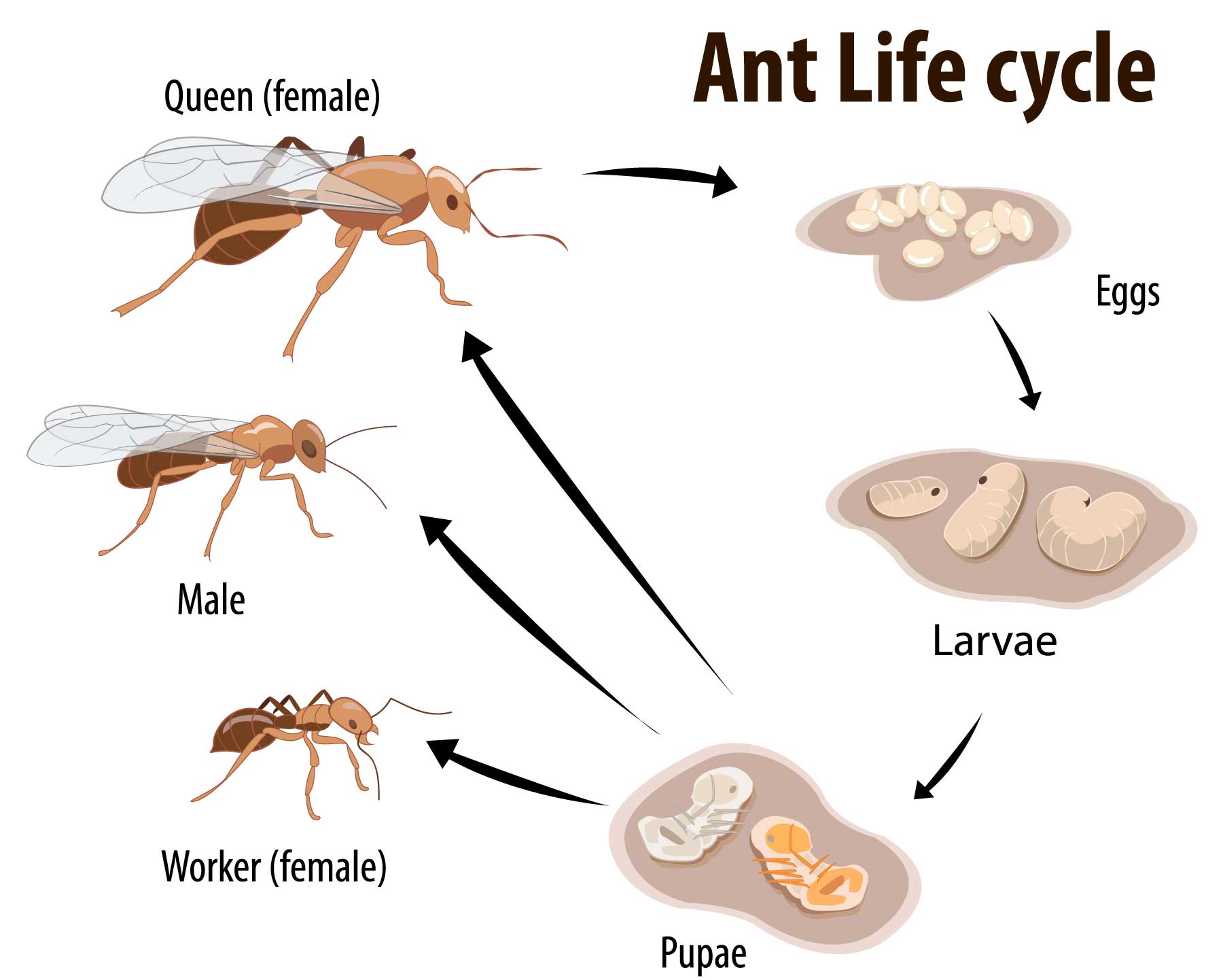
Ants start out as an egg. The eggs are very small, oval, and white – about the size of a grain of sand or period at the end of a sentence. Not all the eggs develop into adults. In fact, some are intentionally eaton by their comrades as they develop.
Eggs hatch into worm-shaped larvae that are fed constantly by the adults as they molt several times. They are ravenous, but with no legs or even eyes they are completely dependent on the adults for nourishment.
After several molts, the larva metamorphose into a pupa. Pupa look much like adults, but their antenna and legs are folded tight against their bodies. This gives them the appearance of a plump grain of rice. Pupa start out white and slowly darken until they emerge as adults.
Young adults are light in color, and continue darkening as they age but never grow any larger. Like all insects, their exoskeletons prevent them from getting any larger.
From egg to adult can take a few weeks to months depending on the species.
Queens are developed by feeding a larva more than all the others. The grow larger than the workers and some species will lay millions of eggs over their lifetime of up to several decades. Though a queen has wings to enable her to find suitable mates, they will tear them off when starting a new colony.
Feeding a female larva less produces a Worker. They don’t lay eggs, but are responsible for the care and feeding of the brood. They also gather food, create the nest, and keep it clean. They are the most prevelant in the nest, doing all the work and only live a few months.
Males have wings and fly to mate with queens. They live for only a few weeks and do no work in the nest.
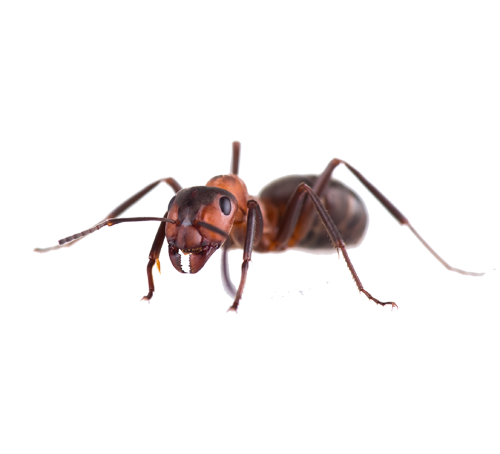
Bed Bugs
Bed bugs are a nasty problem, but like most problems, early detection and proper treatment are the keys to eliminating the problem. According to the CDC, the best way to prevent bed bugs is regular inspection for the signs of an infestation. Why not a bite? Bed bugs are similar to many other insect bites and cannot be identified with any degree of regular accuracy. Also, reactions vary greatly from person to person – from no reaction to large welts. So, inspecting for bed bugs is the best way to catch them early.
Inspecting for Bed Bugs
Inspecting for bed bugs is easier than you think. Here are some common signs and places to check:
Check these spaces
Your bed clothing (pajamas, under clothing) – layer by layer
The seams and folds of the sheets, quilts, pillowcases, mattress, and box springs
Any crack or crevice as wide as the thickness of a credit card within three (3) feet of the bed – nightstands, headboard, bed frame
Look for these signs
Blood stains on your sheets or pillowcases
Dark or rusty spots of excrement on sheets and mattresses, bed clothes, and walls
Bed bugs fecal spats, egg shells, or shed skins in areas where bed bugs hide
An offensive, musty odor from the bugs’ scent glands
Bed Bugs
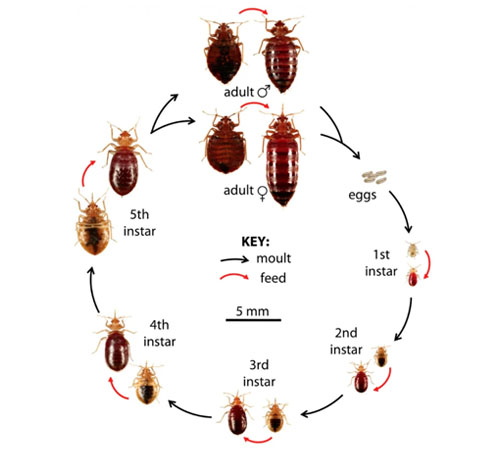
Feeding Behavior
Bed bugs spend the majority of their time hiding together in cracks and crevices. They become active at night, between midnight and 5:00 AM. The CO2 emitted while breathing and body heat attract bed bugs. Because they can’t detect CO2 from more than three feet away and from an even closer distance for body heat, you can expect them to remain near bedding. They are able to move quickly and it is thought that they do a lot of wandering before being able to locate their food. Ideally, most bugs would aggregate near the host’s bed, on the mattress, or in the box springs when not feeding. Once a bug finds the host, they probe the skin with their mouth parts to find a capillary space that allows the blood to flow rapidly into their bodies.
Egg Production
On average:
- A female bug will produce between 1-7 eggs per day for about 10 days after a single blood meal. She will then have to feed again to produce more eggs.
- A female can produce between 5-20 eggs from a singe blood meal.
- The number of male and female eggs produced is about the same (1:1 ratio).
- A single female can produce about 113 eggs in her whole life.
- Eggs can be laid singly or in groups. A wandering female can lay an egg anywhere in a room.
- Under optimal conditions, approximately 97% of the bed bug eggs hatch successfully.
- In the presence of a host, a bed bug population can double every 16 days.
Development
The time for a bed bug to develop from an egg, through all five nymphal instars, and into a reproductive adult is approximately 37 days. Even under the best conditions, some bed bug nymphs will die prior to becoming adults. The first instars are particularly vulnerable. Newly hatched nymphs are exceptionally tiny and cannot travel great distances to locate a host. If an egg is laid too far from a host, the first instar may die of dehydration before ever taking its first blood meal. However, laboratory studies have found that overall bed bug survivorship is good under favorable conditions and that more than 80 percent of all eggs survive to become reproductive adults.
Adult Life Span
The most recent studies indicate that a well-fed adult bed bug held at room temperature (>70° F), will live between 99-300 days in the laboratory. Unfortunately, we do not know exactly how long a bed bug might live in someone’s home or apartment. No doubt it will be at least several months.
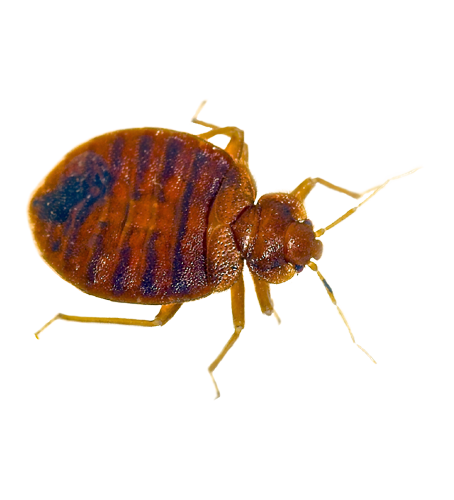
Rodents
Whether Mice, Rats, Voles, or Gophers, rodents are an unwelcome visitor to your yard or home. They chew up the grass, small trees, flower bulbs & roots, and leave unsightly mounds or yellow trails in the grass. They also carry and spread disease through their urin and feces. Fortuntately, PestEx is skilled at eliminating these unwanted intruders and establishing deturants to help keep them away.
Mice Biology and Behavior
The adult House Mouse weighs about 2/5 to 4/5 ounces. They are generally grayish-brown with a gray or buff belly. Similar mice include the white-footed mice, white bellied jumping mice and harvest mice. Native to central Asia, they migrated with early settlers to America. Because they tend to move into homes during the winter looking for food and warmth, they commonly cohabitate with humans as do Norway and roof rats. They have been very successful since their arrival, spread across North America and are now found in every state.
Habitat: House mice live in and around homes, farms, commercial establishments, as well as in open fields and agricultural lands. The onset of cold weather each fall in temperate regions is said to cause mice to move into structures in search of shelter and food.
Food Habits: House mice are “nibblers” they prefer seeds and grain but will try nearly anything available. They like high sugar, fat and protein foods like peanut butter, chocolate, bacon, candy, nuts and butter. A single mouse eats only about 3 grams of food per day (8 pounds per year) but will destroy much more than that due to the nibbling and discarding behavior. Unlike rats, they can get by with little or no drinking water, they can obtain all the water they need through the food they eat though this may not be optimal for reproduction which is reduced in severely dry conditions.
General Biology, Reproduction, and Behavior: House mice are primarily nocturnal, but are frequently active during the day as well. Seeing mice during the day does not necessarily mean there is a high. Mice have poor eyesight, but have keen hearing and an excellent senses of smell, taste and touch.
House mice will burrow into the ground for shelter when other options are not available. Nesting may occur here or in any sheltered location. They construct 4 to 6 inch ball-like nests of fibrous material loosely woven together. About 3 weeks after mating the mother gives birth to 5 or 6 naked young with closed eyes and ears. In two to three weeks they are covered with hair with ears and eyes open and ready to mate as early as 6 to 10 weeks. Under the right conditions mice breed year-round. A female may have 5 to 10 litters per year.
Mice rarely travel more than 30 to 50 feet from their home each day foraging for food and water. They lean the area around their home well memorizing food locations, paths to and from water, where danger may be etc. They quickly detect new objects in their environment, but they do not fear novel objects as do rats. This behavior should be remembered if faced with a large population of mice in a residential, industrial or agricultural setting. Proper placements of mouse bait is a must if you are to have a successful baiting program.
Voles Biology and Behavior
Voles are often mistaken for mice, usually a field mouse or even a mole, however Voles are a very different rodent. Instead of tunneling deep and eating worms and grubs like a mole or scurrying everywhere looking for food and cover like a mouse, Voles make their tunnels at or near the surface of the ground. Sometimes they look like little pathways through the grass just above the roots. In the winter they make paths through the grass under the snow. When the snow melts you will see distinct yellowish trials all through the grass. Not a happy sight for a homeowner.
Voles are often thought to be the most difficult rodent to control. They multiply quickly and will devastate a yard, garden, flower beds and girdle young trees killing, in a matter of days.
Voles, like mice, carry disease and pathogens. Use protective clothing and extreme caution when handling traps, bait stations that have live or dead Voles in them.
Vole Control measures
- Eliminate dense vegetation, live or dead, around your yard
- Eliminate and ground cover around trees and shrubs
- Wrap the base of trees less than 6 inches in diameter with ¼ in hardware cloth leaving at least 1” gap between hardware cloth and trunk of tree all the way around to a height of 12”
- Voles rarely stray from established paths so set traps on, in or adjacent to established paths.
- Poison baits are effective if you can find one that your voles will eat. This can be a challenge and take several attempts.
- Vole repellents can be effective if applied and reapplied consistently.
Gopher Biology and Behavior
Pocket Gophers are one of Idaho’s most prevalent and destructive rodents. They get their name from the fur-lined pouches or pockets in their cheeks. Like a squirrel they use the pouches to carry nesting material, and food. Pocket Gophers come in many shades of brown and black. The have relatively small eyes, small ears and flattish heads that are slightly wider than their shoulders. The tunnel with powerful front feet with large claws.
Gopher burrows are a network of main tunnels, lateral offshoots and nest chambers. They push the unwanted dirt to the surface creating 12” to 18” inch wide crescent shaped mounds about 5” high. A single burrow system can range from 200 to more than 2000 square feet.
Gophers eat all kinds of plants and roots including: young tree roots, flower bulbs, vegetables of all kinds, grasses, seeds and tubers. It’s easy to see why they are so destructive to landscaping and gardens
Other interesting Gopher facts:
- Life span is 3-5 years
- Active year round (they do not hibernate)
- Sexually mature at 1 year of age
- Give birth to 1 or 2 litters of pups per year in spring or summer
Gopher control methods:
- Trapping – Most common usually works well with small populations
- Poisoning – Very common but baits are not always effective and can be difficult to place
- Caron monoxide – Expensive but effective on larger populations. No immediate indication of effectiveness
- Acetylene and oxygen mixture – Can be dangerous, Expensive, Effective on large populations, usually leaves scars on the surface from the underground explosion.
Rats Biology and Behavior
Rat Biology
There are several different species of rats in the treasure valley with many similarities and some notable differences. Here are some things they have in common.
Life Cycle – A female rat becomes sexually mature at about 5 weeks. She will produce up to 6 litters of 5 to 14 pups each in a single year. Gestation is just 3 weeks and they are on their own at 4 weeks old. It’s easy to see how rat populations can explode if left unchecked.
Though life expectancy is around a year to 18 months, they can live as long as three years. Life span is impacted by several factors including environmental conditions such as food, water, and climate. Predators , conflicts with other rats and human extermination efforts are also a part of that equation.
Rat Behavior
Rats come into contact with humans usually looking for food, water, and shelter. Like most foragers they go where the living is easiest. Give them easy access to a warm dry place with food and water nearby and they will move in and multiply. Rats eat anything you would eat and a lot of things you won’t if they have access to garbage, grain, composted vegetation, fruits, vegetables etc. it’s a rat banquet.
They are mostly active just after sunset, and just before sunrise. They can work as an effective team to move food around and to forage for the entire nest. Also, they are known to hoard food for a later time.
Water will normally be the most important factor in determining their nest location. In fact, the elimination of water sources on your property could actually cause them to move out.
Rat Prevention
Removing food, Water and access to easy shelter are the keys to discouraging rats from moving in. Repair holes or gaps in fascia, siding and roofing. Check and reinforce old soffit, cable and other attic vents with ¼ inch heavy gauge hardware cloth. Secure garbage, compost, animal food and other easy opportunities for rats to indulge.
Despite all our efforts, sometimes nature will have it’s way and some rodent maybe a rat will decide he likes your home as much as you do. In that case you can call on your PestEx professionals to show him or them the way out and take the proper steps to keep them out.
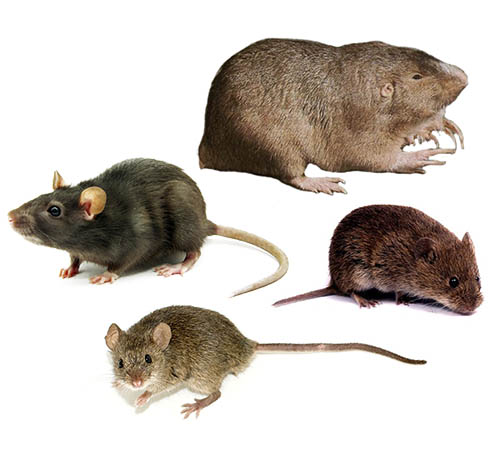
Earwigs
First thing to know about earwigs is that they do NOT crawl into human ears to make nests or lay eggs or pinch your ear drum as my older brothers told me. They also do not bite or pinch people. In fact, bug literature about earwigs states that they are harmless to people. The earwig name was intended to be “earwing” but the “n” was dropped for some reason and the myths grew.
There are people that insist they have been bitten or pinched, but this is highly unlikely. The pinchers are used for defense, in battles to win a mate or to ward off predators. The pincers also help the earwig fold its wings to close them. Yes, they have wings, but don’t panic they rarely fly.
Earwigs – Behavior and Biology
Adults like to hide under objects by day, and often in clusters. They will crawl into small spaces like wall-mounted exterior garage door openers and electrical outlets so beware when reaching out to use these items if you have earwigs in your area.
Earwigs can be beneficial in gardens because they eat aphids. However, they will also eat the roots of planted flowers. They can also render fruits and vegetables inedible with their nibbling if left uncontrolled. In 1924 their population numbers grew so quickly in Portland, Oregon that the city declared a state of emergency. The European Earwig was decimating the states’ crop and fruit tree harvest and measures were taken to eradicate them from the area. These days, they are not likely to pose such a threat and are mostly contained in backyards.
Earwigs can be identified by their pincers at the ends of their abdomen. They are dark reddish-brown, with light brown legs, and adults are a little over ½ inch long.
Females produce up to 60 eggs a year. They make burrows or chambers, 2 to 3 inches deep in the ground. Most species lay one chamber of eggs a year, over-wintering in the soil. Adults and young need consistent moisture to live.
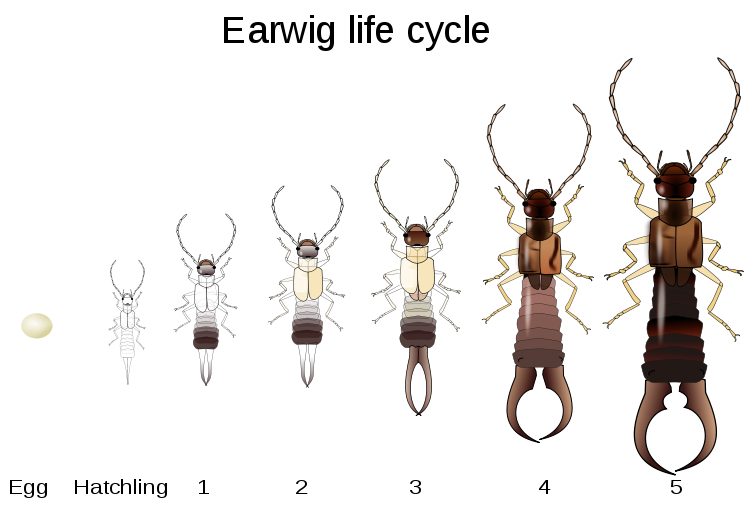
Habits
- Earwigs scavenge for dead insects and decomposing plant material primarily at night as they are mostly nocturnal.
- Depending on the species they may be attracted to light.
- During the day, earwigs will seek shelter under moist organic material, rotting wood, leaf litter etc. They like to stay out of the sun in damp dark places
- They are capable of crop damage if left uncontrolled and numbers spike
- Earwigs are found in homes and can get in through doors, windows, or by going up the foundation.
- Earwigs produce large populations rather quickly building up large numbers around foundations making them a common problem in new subdivisions.
Preventing infestations
- Eliminating moisture around the foundation or in the crawl space, or in organic material around the yard will limit earwig habitat
- Checking for leaky outside faucets or low laying areas were water collects around organic material is important
- Check Rain gutters to be sure they direct water away from the house foundation.
- Caulk or use weather stripping at all possible entry points such as doors, windows, pipes and other entry points at the ground level
- Landscaping with a 24” dry barrier around the foundation with gravel or larger stones is a good preventative measure.
Treatments once Earwigs are present
Removing pest habitats is the key to controlling all insect populations, including earwigs.
Reducing outside lighting at night will avoid attracting certain species that are attracted to light.
Treating outside the building with insecticide is very effective. Be sure to treat all the places Earwigs are likely to be; flower beds, damp organic material of any kind, foundation, up under the siding if not sealed properly and the crawl space. Spring and summer are peak Earwig seasons.
